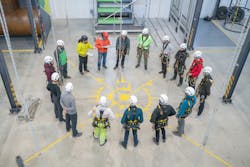Leadership for Lineworkers, Part 7: Tailboards
A tailboard is an organized, pre-planned meeting that occurs on a routine basis with the sole purpose of communicating to the workers about all of the aspects of the job in order to ensure safety, quality and production.
Safety is defined by a discussion outlining, analyzing, identifying and communicating the procedures, methods and rules to ensure that risks are eliminated and/or mitigated.
Quality refers to how the job was built. Was the work done according to the job package, does it meet the construction standards and is the work location(s) clean?
Production relates to whether the work is done in a timely manner as estimated. If not, why not? Were time-specific goals and objectives communicated?
Why and How a Tailboard is Performed
The employer is legally obligated to perform a tailboard. Aside from the fact that the employer wants to ensure worker safety, the tailboard provides a medium for the crew to provide feedback, discuss concerns and to unify on daily basis to enhance crew/team development.
The pre-job should be performed with consideration of the following guidance:
- The Employee-in-Charge (EIC) reviews the work control documents and defines the scope of the work.
- Potential workers are assembled, preferably at the job site, with a walkdown included.
- The work activities are discussed, and any questions are discussed.
- Subject matter experts are involved as needed to review permits or specific job details.
- Leadership is shared among team members, encouraging worker participation by having workers help lead the discussion.
- One-on-one conversations are promoted to help build comfort and involve everyone on the team.
- All assumptions may be challenged; the EIC helps everyone on the team to feel comfortable raising concerns or expressing a lack of understanding.
- Questions are asked, allowing for some silence as people gather their thoughts; letting people finish their sentences before responding in order to hear each participant and demonstrate respect.
Protecting Workers
These meetings--whether called job briefings, tailboards or tailgate meetings—are intended to communicate potential hazards to the workers, review work procedures and address safety measures before the start of a job. The Occupational Safety and Health Administration requires that these meetings be held. Additionally, it is an opportunity for the crew to provide valuable feedback and communication to each other, and create a culture of excellence, teamwork and inclusion.
Throughout my career, I have been on crews where the foreman provided a very comprehensive pre-job briefing or little-to-none. As a line foreman, I provided some pretty detailed tailboards depending on the scope and size of the work.
It is not necessary to go deep into details on repetitive work that are you are doing on a daily basis. For instance; say you are pulling underground cable in a subdivision with no energized cables, clearances or authorizations needed. It’s a brand-new installation. The job will take approximately a week based on the estimated hours included in the job package and the experience of the foreman and the crew.
The bulk of the information is typically provided on the first day. If there are no changes to the original job, a daily tailboard is still necessary/required; despite the fact that the work being performed is routine and mundane. Things can change from day-to-day on the same job due to the weather, access, issues, potential reduction in manpower, vehicle and equipment failures, etc.
A complex job is different. It can require a number of tailboards depending on changing conditions, productivity of the crew(s) and the impact the work has on other stakeholders. Examples are road widenings, reconductors, wire-stringing operations, circuit cutovers, clearances and authorizations, etc.
A job that requires a complex Personal Protective Grounding Scheme has to factor in many variables to ensure that the workers are in an equipotential zone and that the system protection will activate quickly in case of an accidental re-energization. As jobs progress, there might be changes that come into play that require the crew to stand down. The foreman might have to re-evaluate his or her goals and objectives and change the original tailboard to communicate to the crew a change in strategy, guidelines, safety-related issues, etc.
A tailboard/pre-job briefing ensures that the EIC communicates the overall mission of the work, seeks feedback and collaboration amongst the team and most importantly, secures the safety, quality and production of the people and the work, ALWAYS.
Do you have a question about leadership for lineworkers or training and development? Email it to Maximo Fuentes.
